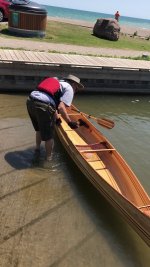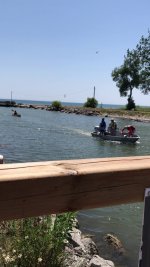So outside finishing is now complete, coming to the end of the build part.
I did a sanding to 120 grit before I removed the hull from the form to do the interior, so now it's time to flip it back and start on getting the exterior varnished.
The plan is to wash the hull with soap and water, then sand it out to 220 grit. After the little issues on the interior, I am not skipping the washing step, it is very little labour and good insurance.
However, first thing I noticed where these little areas of discolouration all over the hull .... didn't know what they were ... but they disappeared with washing
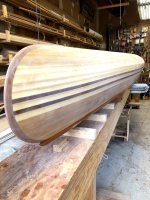
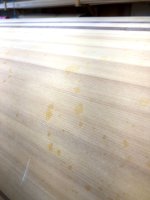
Outside washed, hand sanded to 220 grit, waiting to be vacuumed and tack clothed. The varnish regime is Epiphanes thinned 25% - 20% -15% (using 3 coats on the exterior)
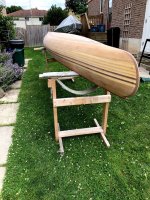
Varnishing going very well, using a 4" roller, apply varnish to about 2-3 square feet at a time, with a couple inch overlap between areas, the varnish gets rolled up/down, then bow/stern direction to distribute varnish evenly. Then tipped to wet edge ... I don't baby this step as I believe speed is one of the more important points, so although I proceed carefully, I also don't waste time ... no phone calls, breaks, no pics (sorry) or interruptions .... get the varnish on, get the varnish distributed, get it tipped off.
The varnish will start skinning quickly, so to maximize the time it has to flow and level I move quickly.
After coat 2
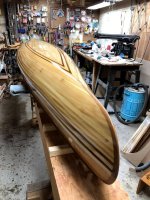
Hand sanding the hull for coat 3, initial hull sanded to 220 grit, for coats 2 and 3 320 grit paper was used ... still using the Norton Pro paper, still totally impressed with it's performance (not a advertisement, sharing what I consider to be a superior product).
I do all the sanding outside ... in fact all the prep is done outside, to avoid introducing all that fine dust in the shop
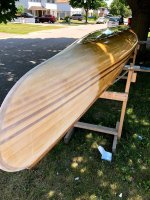
and completed, vacuumed/wiped/tacked ready to move to the shop
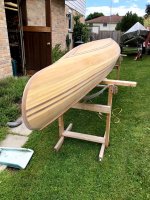
Coat 3 went on without a hitch, after which i left the hull sit for 3 days before flipping and installing the trim stuff.
Now for a few pics of the completed project, on the racks
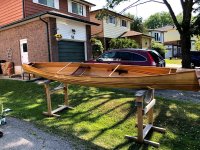
added the yoke in place
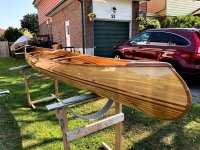
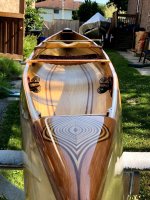
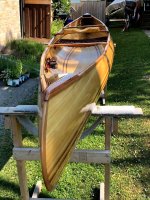
Bottoms up
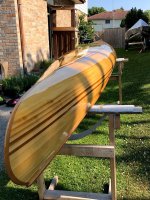
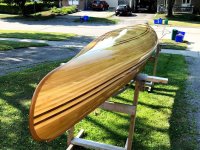
A few thoughts at this point, the varnishing went a lot smoother than usually, with no real issues with dust. I have a theory that most of previous dust issues were related to one thing, the fluorescent lights in the shop. Last few builds I have taken to using a leaf blower to blow out the shop, then hanging plastic to create a dust free zone to varnish in, spraying down the area with water before I bring the canoe back in etc. ... you get the idea.
This time, I decided to do coats 1 and 2 with no plastic, because they would be sanded down anyway, however what I found was they were coming out glass smooth, no nibs, nothing. The only real difference I can figure, was the conversion I did to LEDs last year, I know that fluorescent create static and will attract dust when on, release when turned off ... apparently LEDs don't
Coat 3 went on without any precautions or other dust prevention and again, glass smooth ... in any case it was smooth enough for me and I am thinking that is really what matters.
The project came in over weight budget at 32.5 pounds ... target was 30 pounds, I know part of that overage was the decks I added and likely some more with the decision to increase the thwart size.
Hopefully I will get it on the water, so one more post on impressions and how I intend to mount the yoke (when not in use), which I decided not to do until it was tested on the water.
Brian












